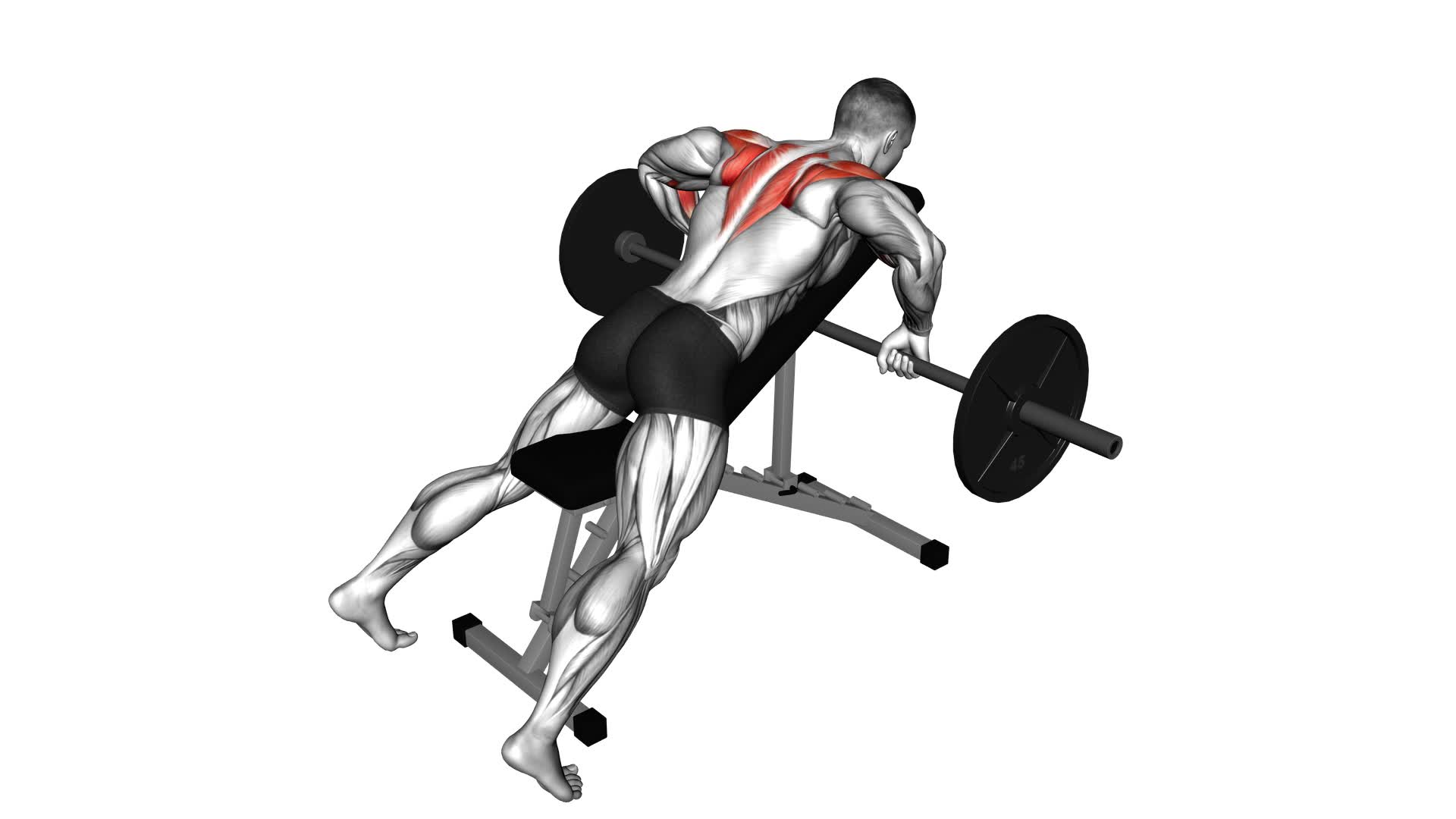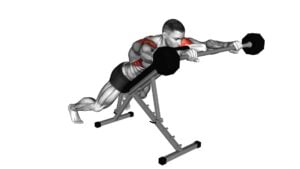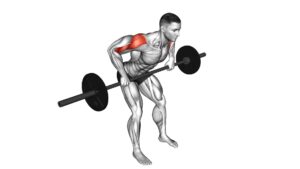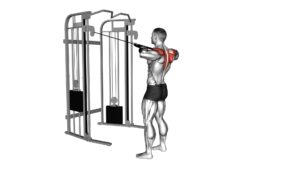Barbell Incline Rear Delt Row – Video Exercise Guide & Tips

Are you looking to target your rear deltoids and build strength in your upper back? Look no further than the Barbell Incline Rear Delt Row!
Watch This Exercise Video
In this video exercise guide, we'll walk you through the proper set-up and equipment, correct form and technique, variations and progressions, common mistakes to avoid, and tips for maximum results.
Get ready to take your upper body workout to the next level with this effective exercise.
Let's dive in!
Key Takeaways
- Proper set-up and equipment are essential for a safe and efficient workout.
- Correct form and technique, such as adjusting the incline bench and maintaining controlled movement, are crucial for the exercise.
- Variations and progressions can be incorporated to prevent plateaus and keep workouts effective.
- Avoiding common mistakes like using excessive weight or maintaining a neutral spine can prevent injuries and muscle imbalances.
Proper Set-Up and Equipment
To properly set up and perform the Barbell Incline Rear Delt Row, you'll need a barbell, an adjustable bench, and weight plates. The importance of proper form can't be emphasized enough when it comes to this exercise. By using proper equipment and maintaining correct form, you can maximize the benefits and minimize the risk of injury.
Firstly, let's talk about the barbell. It should be loaded with an appropriate amount of weight plates, based on your strength and fitness level. Make sure the barbell is securely fastened with collars to prevent any plates from sliding off during the exercise.
Next, the adjustable bench plays a crucial role in setting up the correct incline angle. Position the bench at around a 45-degree angle to target the rear delts effectively. Ensure that the bench is stable and locked in place before starting the exercise.
Using proper equipment allows for a safe and efficient workout. With a stable barbell and a secure bench, you can focus on executing the movement with precision and control. This will engage your rear delts effectively and help build strength and muscle in that area.
Correct Form and Technique
Mastering the correct form and technique of the Barbell Incline Rear Delt Row is crucial for maximizing results and preventing injury. To perform this exercise correctly, start by adjusting the incline bench to a 45-degree angle. Lie face down on the bench with your chest pressed against the pad and your feet firmly planted on the ground. Grasp the barbell with an overhand grip, slightly wider than shoulder-width apart.
As you lift the barbell towards your chest, focus on squeezing your shoulder blades together to engage your rear delts. Keep your elbows close to your sides and maintain a controlled movement throughout the exercise. Avoid using momentum or swinging your body to lift the weight, as this can compromise your form and reduce the effectiveness of the exercise.
Common errors to watch out for include shrugging your shoulders, which can shift the focus away from the rear delts, and allowing your lower back to arch, which can strain your spine. To prevent these errors, engage your core and maintain a neutral spine throughout the exercise.
The benefits and advantages of performing the Barbell Incline Rear Delt Row include targeting the often neglected rear delts, improving posture and shoulder stability, and enhancing overall upper body strength. By mastering the correct form and technique, you can ensure that you're getting the most out of this exercise while minimizing the risk of injury.
Variations and Progressions
Take your Barbell Incline Rear Delt Row to the next level with these variations and progressions. By incorporating advanced modifications and muscle activation techniques, you can continue challenging your muscles and improving your overall fitness.
Here are some variations and progressions to try:
- Single-arm Barbell Incline Rear Delt Row: Perform the exercise with only one arm at a time. This variation increases the demand on your core and stabilizer muscles.
- Tempo-controlled Barbell Incline Rear Delt Row: Slow down the movement, focusing on the eccentric (lowering) phase. This technique enhances muscle activation and promotes greater strength gains.
- Resistance Band Assisted Barbell Incline Rear Delt Row: Attach a resistance band to the barbell and anchor it to a stable object. This modification adds accommodating resistance, making the exercise more challenging at the top of the movement.
- Barbell Incline Rear Delt Row with Pause: Hold the contraction at the top of the movement for a few seconds before lowering the weight. This technique increases time under tension and helps develop better mind-muscle connection.
Incorporating these variations and progressions into your training routine won't only prevent plateaus but also keep your workouts exciting and effective.
Remember to always prioritize proper form and technique to maximize the benefits of each exercise.
Common Mistakes to Avoid
What are some common mistakes you should avoid when performing the Barbell Incline Rear Delt Row? To ensure you have a safe and effective workout, it's important to be aware of these common mistakes that can lead to injuries and muscle imbalances.
Firstly, avoid using excessive weight. Using too much weight can put unnecessary strain on your muscles and joints, increasing the risk of injury. It's important to start with a weight that allows you to maintain proper form and gradually increase the weight as your strength improves.
Secondly, make sure to maintain a neutral spine throughout the exercise. Avoid rounding your back or arching excessively, as this can put excessive stress on your spine. Engage your core and keep your back straight to protect your spine and maintain proper alignment.
Another common mistake is using momentum to complete the movement. It's important to perform the exercise in a controlled manner, focusing on using your rear deltoids to pull the barbell towards your chest. Avoid using your body's momentum to swing the weight up, as this can lead to muscle imbalances and prevent you from effectively targeting your rear delts.
By avoiding these common mistakes, you can ensure a safe and effective Barbell Incline Rear Delt Row.
Now, let's move on to the next section where we'll discuss some tips for maximizing your results.
Tips for Maximum Results
To achieve maximum results with the Barbell Incline Rear Delt Row, you should focus on proper form and engage your rear deltoids throughout the exercise. Here are some tips to help you get the most out of this exercise:
- Maintain proper form: Keep your back straight, chest up, and shoulders back throughout the movement. This will ensure that you're targeting the rear deltoids effectively.
- Control the weight: Avoid using momentum or swinging the weight. Instead, focus on a slow and controlled movement to engage the muscles fully.
- Use a challenging weight: Choose a weight that allows you to perform the exercise with proper form, but also challenges your muscles. Gradually increase the weight as you get stronger.
- Incorporate nutrition guidelines and proper workout frequency: To maximize your results, it's important to fuel your body with the right nutrients. Ensure you're consuming enough protein and eating a balanced diet. Additionally, consistency is key.
Aim to perform this exercise 2-3 times per week, allowing for proper rest and recovery in between sessions.
Frequently Asked Questions
How Many Sets and Reps Should I Do for the Barbell Incline Rear Delt Row?
For the barbell incline rear delt row, it's important to consider the number of sets and reps for optimal results.
By incorporating this exercise into your routine, you can benefit from enhanced shoulder development.
To ensure proper form and technique, it's recommended to start with 3-4 sets of 8-12 reps.
This range allows you to challenge your muscles while maintaining proper form.
Remember to adjust the weight accordingly and listen to your body for any signs of fatigue or discomfort.
Can I Use Dumbbells Instead of a Barbell for This Exercise?
Yes, you can definitely use dumbbells instead of a barbell for the Barbell Incline Rear Delt Row exercise. This exercise has several dumbbell variations that you can try.
While both barbells and dumbbells provide benefits, using dumbbells allows for a greater range of motion and unilateral training, which can help improve muscle imbalances and overall strength.
It's important to choose a weight that challenges you while maintaining proper form to reap the full benefits of this exercise.
Is It Necessary to Warm up Before Performing the Barbell Incline Rear Delt Row?
Before performing the barbell incline rear delt row, it's important to warm up. Warming up helps prepare your muscles and joints for exercise, reducing the risk of injury and improving performance. It increases blood flow, flexibility, and range of motion.
If you don't have access to a barbell, there are alternative exercises you can try, such as using dumbbells or resistance bands. These exercises can still target the rear deltoids effectively.
Can Beginners Perform This Exercise or Is It More Suitable for Advanced Lifters?
Beginners can certainly perform the barbell incline rear delt row, but it may be more suitable for advanced lifters. The exercise can be modified for beginners by using lighter weights and focusing on proper form.
This exercise benefits all fitness levels by targeting the rear delts, improving posture, and strengthening the upper back.
As beginners progress, they can gradually increase the weight and intensity to challenge themselves and continue seeing results.
How Often Should I Incorporate the Barbell Incline Rear Delt Row Into My Workout Routine?
To determine the ideal frequency for incorporating the barbell incline rear delt row into your workout routine, consider your goals and overall training program.
This exercise can be done 1-2 times per week, allowing for sufficient recovery between sessions.
However, it's important to vary your routine and incorporate different variations and modifications of the exercise to target your rear delts from different angles and challenge your muscles in new ways.
Experiment with different frequencies and listen to your body's feedback to find what works best for you.
Conclusion
Incorporating the barbell incline rear delt row into your workout routine can help strengthen your rear deltoids and improve your overall upper body strength.
By following the proper set-up and using correct form and technique, you can maximize the effectiveness of this exercise.
Remember to avoid common mistakes and consider variations and progressions to challenge yourself further.
With dedication and consistency, you can achieve maximum results and enhance your physique.

Author
Years ago, the spark of my life’s passion ignited in my mind the moment I stepped into the local gym for the first time. The inaugural bead of perspiration, the initial endeavor, the very first surge of endorphins, and a sense of pride that washed over me post-workout marked the beginning of my deep-seated interest in strength sports, fitness, and sports nutrition. This very curiosity blossomed rapidly into a profound fascination, propelling me to earn a Master’s degree in Physical Education from the Academy of Physical Education in Krakow, followed by a Sports Manager diploma from the Jagiellonian University. My journey of growth led me to gain more specialized qualifications, such as being a certified personal trainer with a focus on sports dietetics, a lifeguard, and an instructor for wellness and corrective gymnastics. Theoretical knowledge paired seamlessly with practical experience, reinforcing my belief that the transformation of individuals under my guidance was also a reflection of my personal growth. This belief holds true even today. Each day, I strive to push the boundaries and explore new realms. These realms gently elevate me to greater heights. The unique combination of passion for my field and the continuous quest for growth fuels my drive to break new ground.







